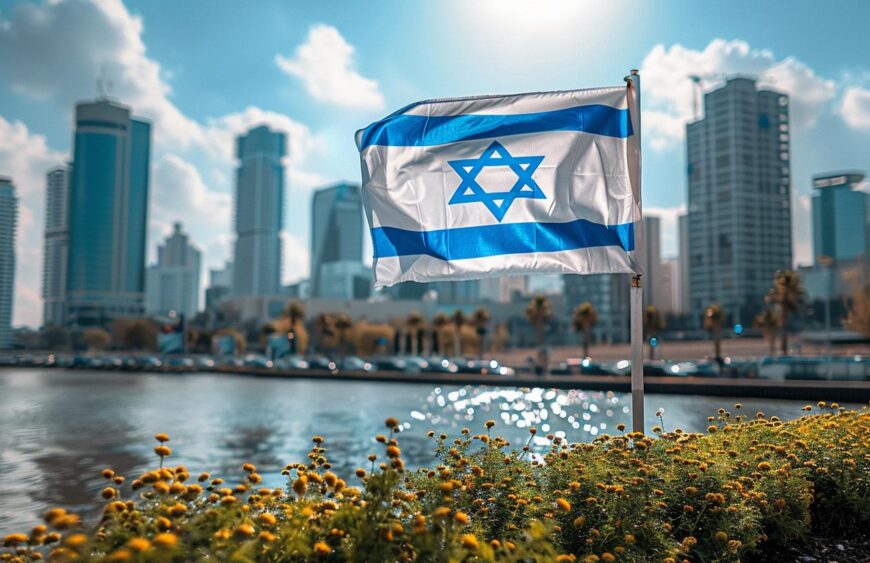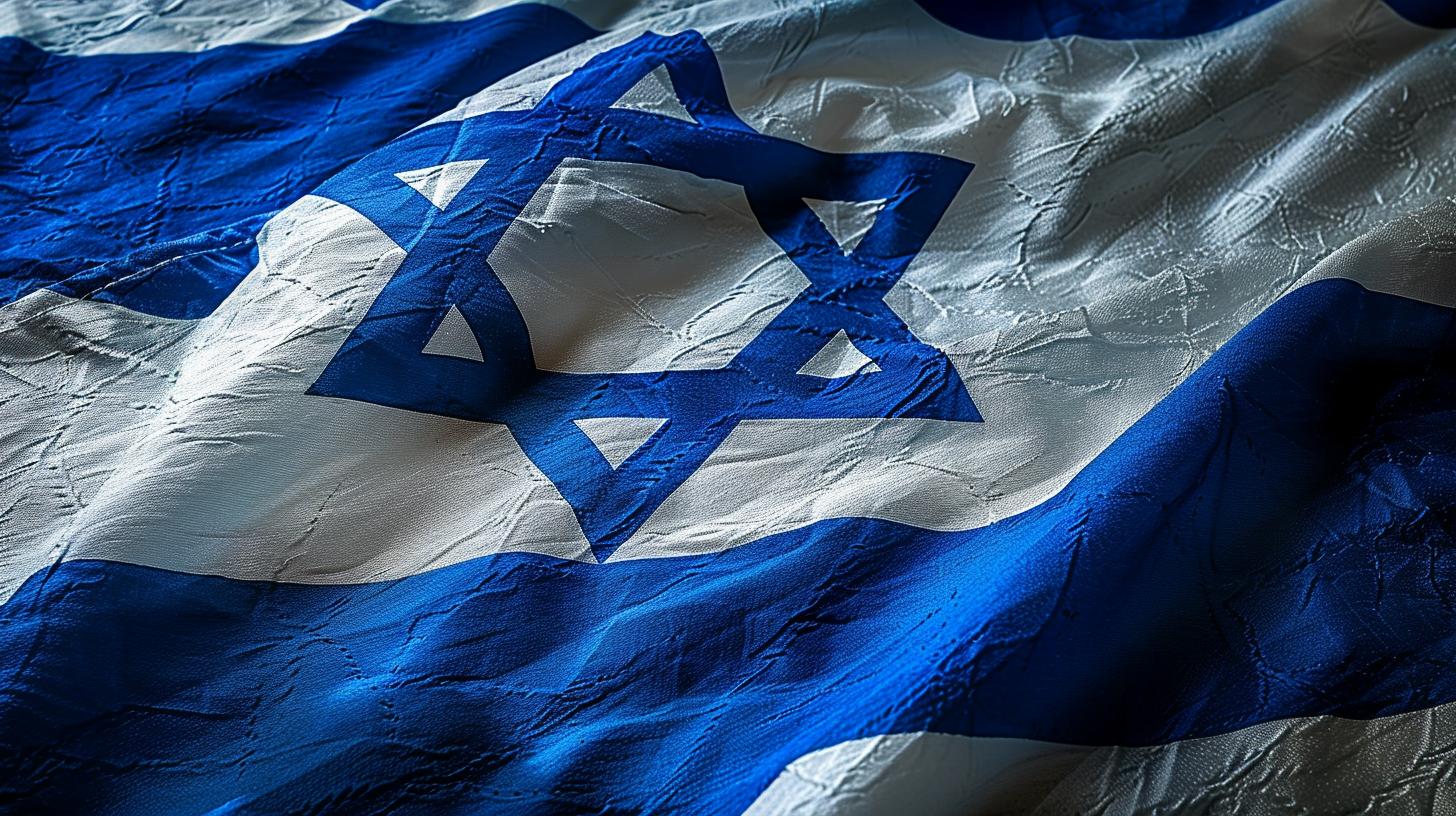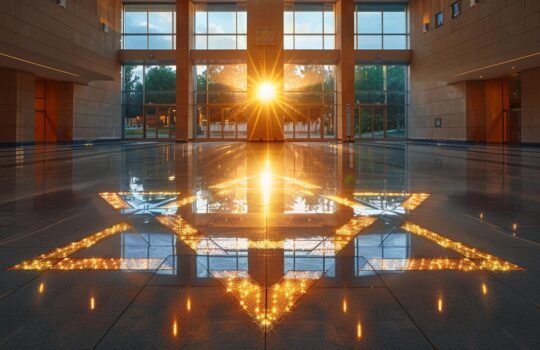Crafting Unity: The Flag of Israel as Artistic Inspiration

The flag of Israel, with its distinctive blue Star of David set between two horizontal stripes, has transcended its role as merely a national emblem to become a canvas for artistic inspiration. This potent symbol, steeped in millennia of history and imbued with profound religious significance, offers itself as a source of creativity for artists around the globe.
By delving into the rich narrative that the flag portrays, artistic expressions born from this icon foster powerful messages that resonate with themes of cultural identity and unity.
Tracing back the origins of the flag’s design lends insight into how these elements have come to represent not only a country but also an entire people’s heritage and beliefs. The flag’s simple yet bold imagery-a harmonious blend of ancient tradition and modernity-narrates a tale far beyond its physical manifestation.
It serves as both a rallying point for the Jewish nation and a bridge connecting communities across diverse backgrounds. Artists have embraced this emblematic power to explore complex notions of cultural solidarity and collective experience within their work.
As we navigate through various mediums where the flag’s influence is evident, from traditional paintings to avant-garde installations, it becomes clear that artists are not just replicating an image; they are interpreting and transforming it. From color palettes to compositional choices, creatives extract the essence of unity inherent within the flag’s motifs to forge works that reach into the heart of shared human aspirations.
These evocative interpretations, drawn from a simple yet profound symbol-the flag of Israel-reveal how art can be both mirror and lamp to society’s values, shining light on paths towards communal harmony and understanding.
The Origin of the Flag and Its Historical Significance
The national emblem of Israel, its flag, carries a profound historical legacy that has been embraced by artists seeking to untangle and express narratives of collective identity. With its origins dating back to the late 19th century, the flag was conceived as a symbol of Jewish independence and resilience during the early Zionist movement.
It was officially adopted on October 28, 1948, shortly after the state of Israel was established. This flag’s creation story intertwines with the overarching journey of a people striving for sovereignty in their ancestral homeland.
Enshrined within the simple yet striking design are symbols laden with historic resonance and religious significance. Central to the flag is the iconic Magen David, or Star of David, which has served as a representation of Jewish identity for centuries. The star is flanked by two horizontal blue stripes near the top and bottom edges-echoes of the traditional Jewish prayer shawl, or tallit.
The white background stands for purity and peace. Each element segues into narratives about survival, tradition, and hope.
- The Magen David (Star of David) remains one of Judaism’s most recognizable symbols, historically found on synagogues and Jewish tombstones long before its inclusion in the flag’s design.
- The blue stripes mirror those found on the tallit (Jewish prayer shawl), symbolizing customary Judaic observances that have united communities in shared practice.
- The choice of white expresses clarity and virtue as foundational aspirations for a nation reborn after enduring tumultuous histories.
As much as it resonates with vivid narratives from past epochs, unveiling how this emblem came to be epitomizes both cultural memory and steadfast determination towards self-determination. Whether upon distant shores or under challenging circumstances throughout history prior to Israel’s foundation as a state, these emblems persisted as markers of faith and kinship-a torch carried forward through generations unyielding in vision for eventual return to Zion.
Together, these elements make up not just a flag but an artifact steeped in meaning-a potent source material from which artists draw inspiration when crafting pieces that speak to unity borne from diverse tribulations now memorialized through hues of blue and white beneath six-pointed stars.
The flag’s pervasive recognition extends beyond borders; it has evolved into an archetype resonating universally while hailing particularism rooted deep within Jewish ethos-a dual heritage acknowledged across canvases worldwide where creators continue interpreting this storied tapestry afresh.
Artistic Representations of Unity Through the Flag of Israel
The Multifaceted Canvas of National Identity
Artists have long turned to the flag of Israel as a vivid canvas through which they express the complexities and depth of national identity. The simple geometric patterns alongside the rich symbolism offer creatives a platform to explore themes such as unity, diversity, heritage, and peace.
Painters, in particular, have found ways to infuse their canvases with interpretations that resonate with both personal and collective narratives. The interaction between the colors and elements of the flag become metaphors for society’s strive towards cohesion amidst its varied cultural landscape.

One striking example is when artists depict communities coming together under the banner of the flag, showcasing it at moments of national triumph or remembrance. Such works often emphasize not only historical achievements but also an aspirational vision-embedding hope within brushstrokes that capture the human yearning for connection. Whether through realistic depictions or abstract interpretations, these artistic portrayals serve to reinforce a shared identity rooted in commonalities rather than differences.
Incorporating Traditional Motifs With Contemporary Issues
The imagery constituting the flag of Israel has provided an inspirational base for diverse art forms seeking to meld traditional motifs with pressing contemporary issues. Digital artists have been particularly adept at this integration-using technology to reimagine age-old symbols in addressing modern social concerns surrounding unity. They may digitally scaffold the Star of David upon scenarios depicting modern Israeli life or superimpose its form over cityscapes showing pluralistic coexistence within urban settings.
Sculpture has also proven a thought-provoking medium wherein the three-dimensional interpretations draw observers into an experiential relationship with both space and symbol. Public sculptures incorporating elements from the flag might invite individuals from different backgrounds to partake in shared experiences-turning static art into interactive nodes where communal narratives can be woven together.
Fusing Artistry With National Heritage
Perhaps no other realm has seen quite as much diverse representation using elements from the flag as performance arts and community projects aiming at solidarity. Through dance, theater productions, and music videos, performers have donned attire inspired by the flag’s design while engaging audiences in storytelling that underscores unity rooted deeply within Israeli history yet evolving overtime.
Community-driven street art initiatives often employ murals featuring aspects of the flag in conjunction with other cultural insignia-a practice which renders walls throughout various neighborhoods storytelling tapestries chronicling societal convergence. Here we witness firsthand how tangible applications extend beyond mere representation; they embody active invitations for citizens to partake in corporeal dialogues revolving around shared heritage and future aspirations.
In each case-from traditional painting techniques to cutting-edge digital compositions-the artistic amalgamation reflects not just an individual’s experience but collectively echoes broader societal sentiments. The flag of israel thus provides more than just patriotic fervor; it delivers an unbounded mosaic where past meets present, individual blends into community, and artwork underpins notions inherent within utopian quests for unity.
The Flag of Israel in Modern Design and Fashion
Modern design and fashion have masterfully woven symbols into everyday aesthetics, and the flag of Israel stands as a prominent example of this trend. The distinct blue stripes and Star of David against its white fabric create a graphic quality that designers have found to be both meaningful and visually commanding. Drawing from these elements, there has been an increasing integration of the flag’s motifs into various domains, ranging from interior decoration to contemporary apparel.
- In interior design, the color scheme and geometric patterns associated with the flag of Israel can be seen accenting homes in the form of wall art, throw pillows, and even dinnerware sets. The use of its imagery adds a personal touch for those who feel connected to Israeli culture or wish to express solidarity with the country.
- The fashion industry has also adopted aspects of the flag’s design. Clothing lines feature shirts, dresses, and scarves that use the blue-and-white palette or iterations of the Star of David in their prints. Hats, pins, and other accessories adorned with miniature versions or abstract representations are popular among various age groups across both casual wear and high fashion.
- Even footwear has not escaped this influence. Sneakers incorporating subtle nods through their colorway or direct emblems provide a walking testament to national pride or stylish preference for iconic symbology.
The incorporation of national symbols into popular culture does more than just offer aesthetic appeal; it serves to disseminate identity and shared values in public spaces. The omnipresence of these designs enables conversations around heritage and history while aligning them within modern contexts.
Despite being imbued with political significance, when translated into design elements, the flag’s components often transcend their origins to assume a place within style statements. This harnessing poses potential challenges when navigating political sensitivities but also floors open new opportunities for cross-cultural dialogues.
Treading carefully between political statement and aesthetic expression underscores a delicate balance where style meets symbolism. For some consumers, wearing iterations inspired by the flag represents affiliation or respect for Israel’s cultural narratives; for others, it is purely about embracing interesting patterns without necessarily signaling allegiance.

Designers who opt to incorporate such meaningful icons must consider their audience’s perspectives; are they creating pieces that speak volumes about identity? Or could they be unwittingly watering down powerful insignia through commercial proliferation? These questions echo in studios around the world as creators strive to honor tradition while answering calls for innovative fashion frontiers.
Throughout this marriage between patriotism and palette – pushing trends lies an intriguing dialogue on modern nationalism expressed through artistic means-a fusion where proudly displaying elements borrowed from the flag of israel becomes both an aesthetic choice as well as a conversation starter about belongingness in an increasingly interconnected global community.
Educational Projects and Community Art Inspired by the Flag
Educational initiatives often aim to blend cultural appreciation with artistic creativity, and the flag of Israel has become an instrumental tool in this context. Schools and community centers sometimes launch programs centered around the flag’s symbolism, using it as a starting point for discussions about history, politics, and art.
These projects serve multiple purposes: educating participants about the national emblem’s origins and meaning while also encouraging them to express their personal and collective identities through art. Children and adults alike engage with hands-on activities such as drawing, painting, or even creating digital representations of the flag.
Interactive community art projects have also harnessed the power of the flag of Israel to unite people from varied backgrounds. For example, some public installations might invite community members to contribute a piece to a larger mosaic of the flag, each adding their unique flair or message within a small tile or segment.
Such collaborative efforts strive not only to beautify public spaces but also to represent the fabric of society itself-a tapestry woven together by diverse individuals yet standing strong as one entity. These endeavors often elicit powerful responses from participants and passersby alike, echoing themes of solidarity and coexistence.
Interviews with community leaders or educators involved in these projects reveal a sense of pride and optimism. They report witnessing firsthand how art can bridge gaps between different segments of society and how an iconic symbol like the flag can serve as a rally point for common values. Despite varying opinions on political matters among participants, when it comes to crafting something together inspired by the flag, there appears to be a shared sense of purpose that transcends individual differences.
| Project Type | Objective |
|---|---|
| Educational Initiatives | Teaching about history; Encouraging creative expression related to national identity. |
| Community Art Projects | Promoting unity; Beautifying public spaces; Reflecting diverse community contributions. |
Challenges and Controversies Surrounding Artistic Interpretations
Artistic use of national symbols, including the flag of Israel, often walks a tightrope between honorific representation and provocative interpretation. The powerful imagery and symbolism inherent in national flags can evoke strong emotional responses, which is both a tool and a challenge for artists. On one hand, such symbols can unify viewers under a shared sense of identity; on the other hand, they can also stir up controversy when reimagined or repurposed in art.
The flag of Israel, with its deep religious ties and connection to Jewish history, is no stranger to contention. Instances occur when artists who choose to incorporate the image of the flag into their works may find themselves at odds with those who feel the interpretations are disrespectful or politically charged.
For some people within Jewish communities around the world and in Israel itself, altering or manipulating the appearance of the flag can be seen as dishonoring tradition or religious significance. In these cases, dialogue becomes an essential tool for artists to explain their intentions and for critics to state their perspectives.
However contentious it might be to use such potent symbols in art, these debates generally foster an invaluable conversation about freedom of expression and respect for cultural heritage. It’s common for artworks featuring national symbols like the flag of Israel to become arenas where issues of patriotism versus artistic license are publicly negotiated.
Some argue that by pushing boundaries, artists invite us to examine our own interpretations and assumptions about these emblems; others maintain that certain lines should not be crossed due to reverence for what these symbols represent.
| Year | Event | Description |
|---|---|---|
| 2004 | Art Exhibition Controversy | An artist’s rendition featuring fragments of the Israeli flag generated public outcry over perceived disrespect. |
| 2010 | Fashion Statement Backlash | A fashion line utilized elements from the flag which was seen as inappropriate commercialization by some groups. |
| 2018 | Cultural Event Dispute | An artist’s installation involving deconstructed flags triggered fierce debates over limits in interpretive artwork. |
Engagement with such controversies ensures ongoing discussions about national pride, historical consciousness, and ultimately heightens awareness regarding the sensitivities linked to using significant cultural symbols in creative work. These challenges underscore both the risks and opportunities that come with reenvisioning icons like the flag of Israel within an artistic context.

Conclusion
Throughout this article, we have seen how the flag of Israel transcends its function as a mere national emblem and doubles as a potent canvas for artistic expression and cultural narrative. The rich blue stripes, stoic Star of David, and pristine white background carry with them the weight of history and symbolism, collectively inspiring artists to convey messages that resonate well beyond the boundaries of visual aesthetics.
These artists are tapping into a deep wellspring of tradition to build bridges across communities and foster dialogues centered on peace and unity.
As art continues to evolve in tandem with societal changes, so too does the manner in which the flag is reimagined and reinvented. From high-fashion statements to modern design elements within our daily living spaces, the flag’s motifs make their mark on popular culture while serving as a reminder of shared identity.
It is this harmonious dichotomy between political significance and aesthetic appeal that prompts us to reflect upon our perceptions of national symbols. The inclusion of the flag of Israel in diverse artistic works showcases an ever-present yearning for innovation melded with reverence for heritage.
Looking ahead, it is likely that the flag will persist as a dynamic instrument within the artist’s palette-a representation not just of where we come from but who we aspire to be. Whether through educational endeavors that captivate young minds or community projects that unite differing voices, the imagery inherent in the flag serves as both cornerstone and launching pad for narratives centered on concord and progress.
May future creative undertakings grounded in these hallowed colors continue to forge pathways toward common ground, celebrating both individualism and collectivity-a testament to art’s enduring power in shaping perspectives and embracing diversity under one symbolically stitched canopy.
Frequently Asked Questions
What Is the Flag for Jerusalem?
Jerusalem does not have a unique flag separate from the flag of Israel, which features a blue Star of David between two horizontal blue stripes against a white background. As the proclaimed capital city of Israel, Jerusalem generally uses the national Israeli flag for official purposes.
What Is the Zionist Flag?
The Zionist flag is essentially the same as the current national flag of Israel. It was originally designed to represent the Jewish people and later adopted as the symbol of Zionism—a movement supporting the re-establishment of a Jewish homeland in what is now Israel.
What Is the Red Israeli Flag?
There isn’t an official red Israeli flag, but there is a Red Shield of David also known as Magen David Adom, which serves as the emblem for Israel’s national emergency medical, disaster, ambulance, and blood bank service.
It features a red Star of David on a white background and is often seen on ambulances and medical facilities in Israel.
Why Does the US Support Israel?
The US supports Israel for a variety of historical, political, cultural, and strategic reasons. This includes shared democratic values, strong historical ties bolstered by substantial Jewish-American communities’ influence and advocacy, strategic cooperation in regional security matters including intelligence sharing and counter-terrorism efforts, as well as mutual economic investments.
What Is the Israel Flag Controversy?
The controversy surrounding the Israeli flag primarily stems from conflicting narratives between Israelis and Palestinians regarding sovereignty and statehood. For many Palestinians and their supporters, the Israeli flag symbolizes dispossession and occupation whereas for Israelis it represents national identity and self-determination.
Is Jerusalem in Israel or Palestine?
Jerusalem’s status remains one of the most sensitive issues in the Israeli-Palestinian conflict with both Israelis claiming it as their capital while Palestinians consider East Jerusalem—which includes major Muslim, Jewish, and Christian holy sites—as their future capital under international proposals for two independent states.
What Is the Symbol of Jerusalem?
The Lion of Judah traditionally serves as a culturally rich symbol associated with Jerusalem representing strength as it was previously featured on Jerusalem’s municipal emblem signifying its historical relevance connecting back to Biblical tribes associated with this animal.
What Is the Symbol of Jerusalem Israel?
In modern times, several symbols are commonly identified with Jerusalem however prominent among them aside from religious iconography such as the Western Wall or Dome of Rock would be still be that Jerusalem municipal emblem which showcases a stylized lion reminiscent of various Old Testament references including those saluting King David who established it thousands years ago.





